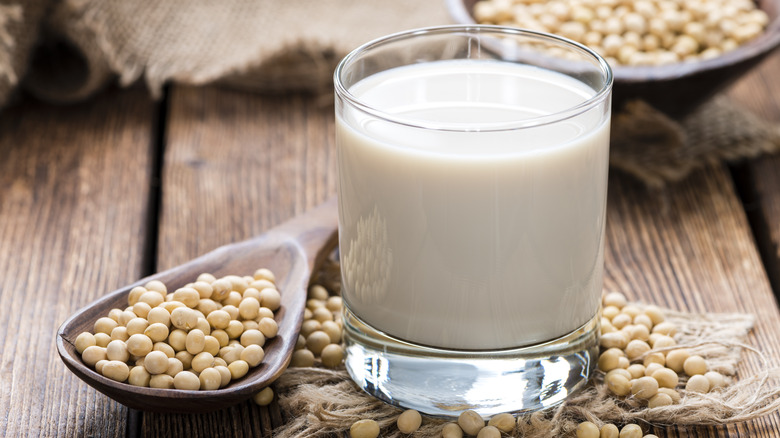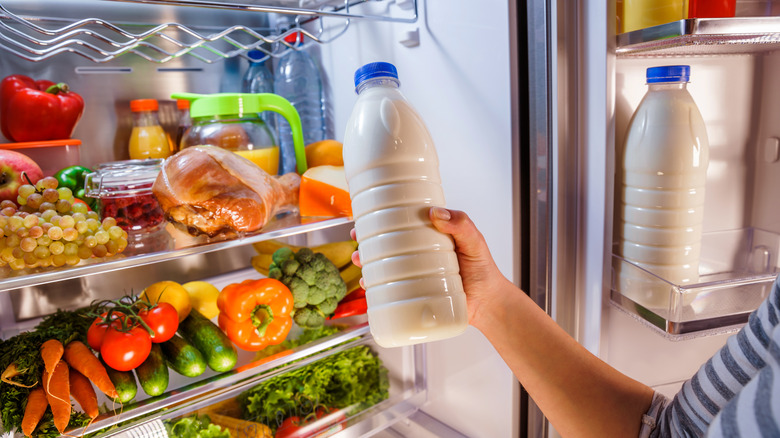How To Tell If Soy Milk Has Gone Bad
Soy milk differs from its dairy counterpart in many ways, but its shelf life isn't one of them. This plant-based product is often sold in shelf-stable cardboard boxes, but once opened, all soy milk spoils in a similar time frame as cow's milk. Shelf-stable soy milk that's left unopened will stay fresh for anywhere between three to six months past the use-by (not sell-by) date on the package. If it's the refrigerated kind, you'll have about a week to use it up after the date passes. Once opened, both varieties can go bad in five days.
When soy milk spoils, one of the first things you might notice is that the package is bloated. Milk becomes infested with bacteria as it spoils, and these germs release gasses that get trapped inside the carton or bottle, making it swell. The color, consistency, and smell of the soy milk are the other major indicators of spoilage. Mold is an obvious red flag, and so is a curdled, thick, lumpy consistency. The liquid might also separate and turn slimy.
Be on the lookout for dark discoloration, too, as fresh soy milk will always have an off-white color. Spoiled soy milk may also develop a sour and rancid odor, so always give it a good whiff if you're skeptical of its freshness. Discard the drink if you notice any of these signs, as consuming spoiled soy milk can lead to foodborne illnesses, with symptoms such as nausea, diarrhea, and stomach pain.
Store soy milk properly to prevent it from spoiling too quickly
As with most perishable items, soy milk's expiry date isn't set in stone. While five days is a decent rule of thumb for opened packages, the milk can last for ten if it's handled well — which is about the same amount of time that an open bottle of almond milk will also last. It largely depends on how you store the drink.
Soy milk that you buy in the refrigerated section should always be kept in the fridge, but unopened shelf-stable soy milk can stay on the counter in a cool and dry place. Once opened, though, it's best to pop it in the fridge. Homemade soy milk should be stored with even more care, as it obviously lacks preservatives to stabilize it. Refrigerate it immediately after making it, and it can last for three to five days.
Another way to prevent soy milk from going bad is to freeze it. You can put the entire carton in the freezer, or transfer the milk into freezer-safe bags first. Alternatively, you could also pour it into an ice cube tray to make single-serve portions. When you want to enjoy it, place the frozen milk in the refrigerator and let it thaw overnight. One thing to keep in mind is that frozen soy milk can separate after it thaws, but can be restored to its original texture after a quick shake — don't mistake separation for spoilage, in this case.
More important tips for storing soy milk
To really stretch the shelf life of your soy milk, mind its storage temperature. It's important to keep the milk away from heat at all times. Shelf-stable soy milk can only stay on the counter if the room isn't too hot. If the ambient temperature in your kitchen is higher than 70 degrees Fahrenheit (which is considered "room temperature"), it's best to store soy milk in the refrigerator from the start.
On a related note, make sure to keep soy milk at the very back of the fridge, rather than the door, which is the one place in your fridge where you shouldn't store milk. Fridge doors are prone to temperature fluctuations as you open and close them, which can cause milk to spoil faster. Once the milk is refrigerated, make sure to never leave it at room temperature for longer than two hours, or it might foster harmful bacteria.
Another thing to be careful of is soy milk's exposure to air. Bacteria can quickly multiply when air comes into contact with milk, so make sure to seal the carton or bottle tightly after each use, or transfer it to an airtight container if the package is a bit flimsy. With these tips, you might be able to enjoy your soy milk past the five-day mark.



